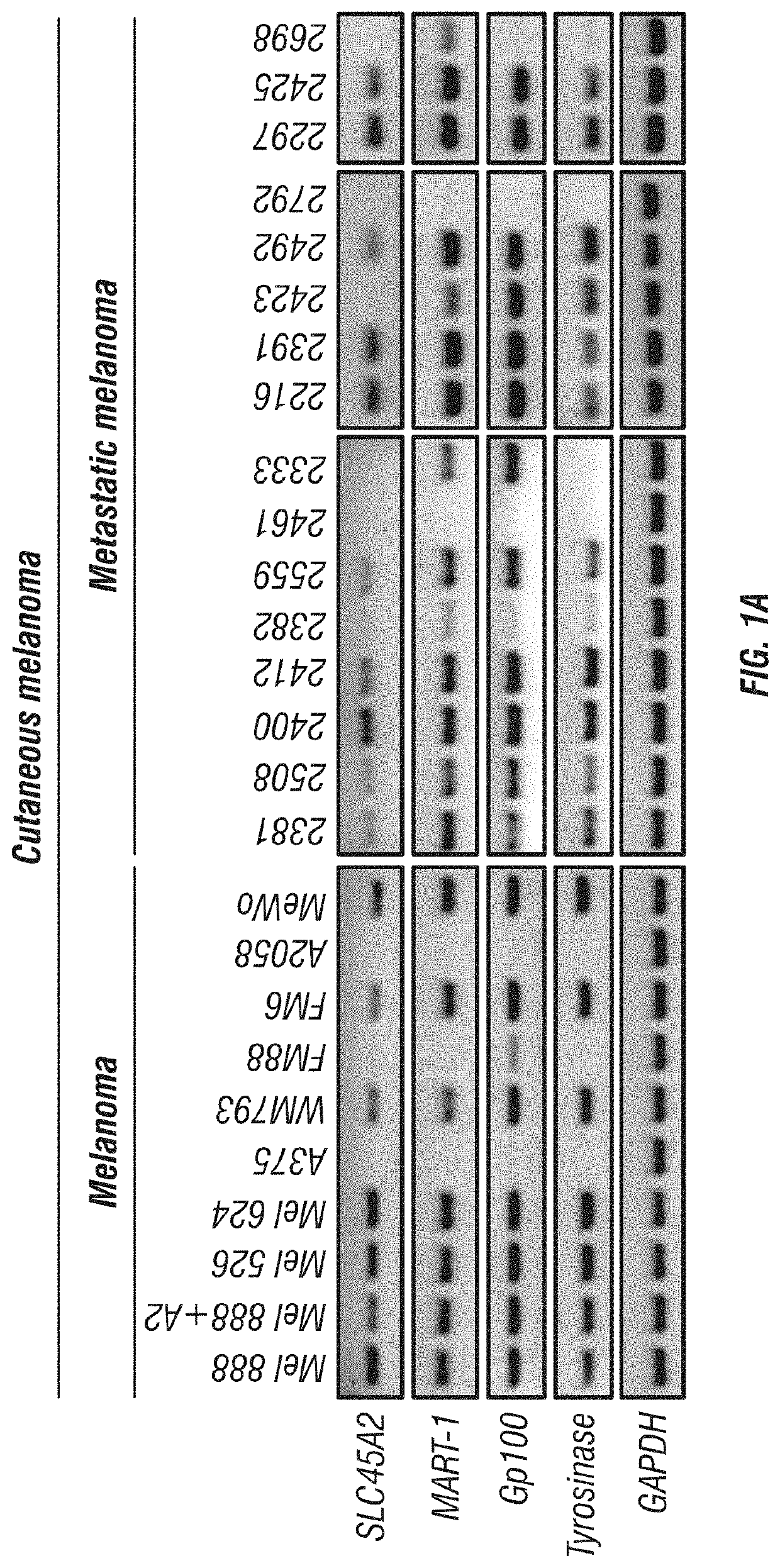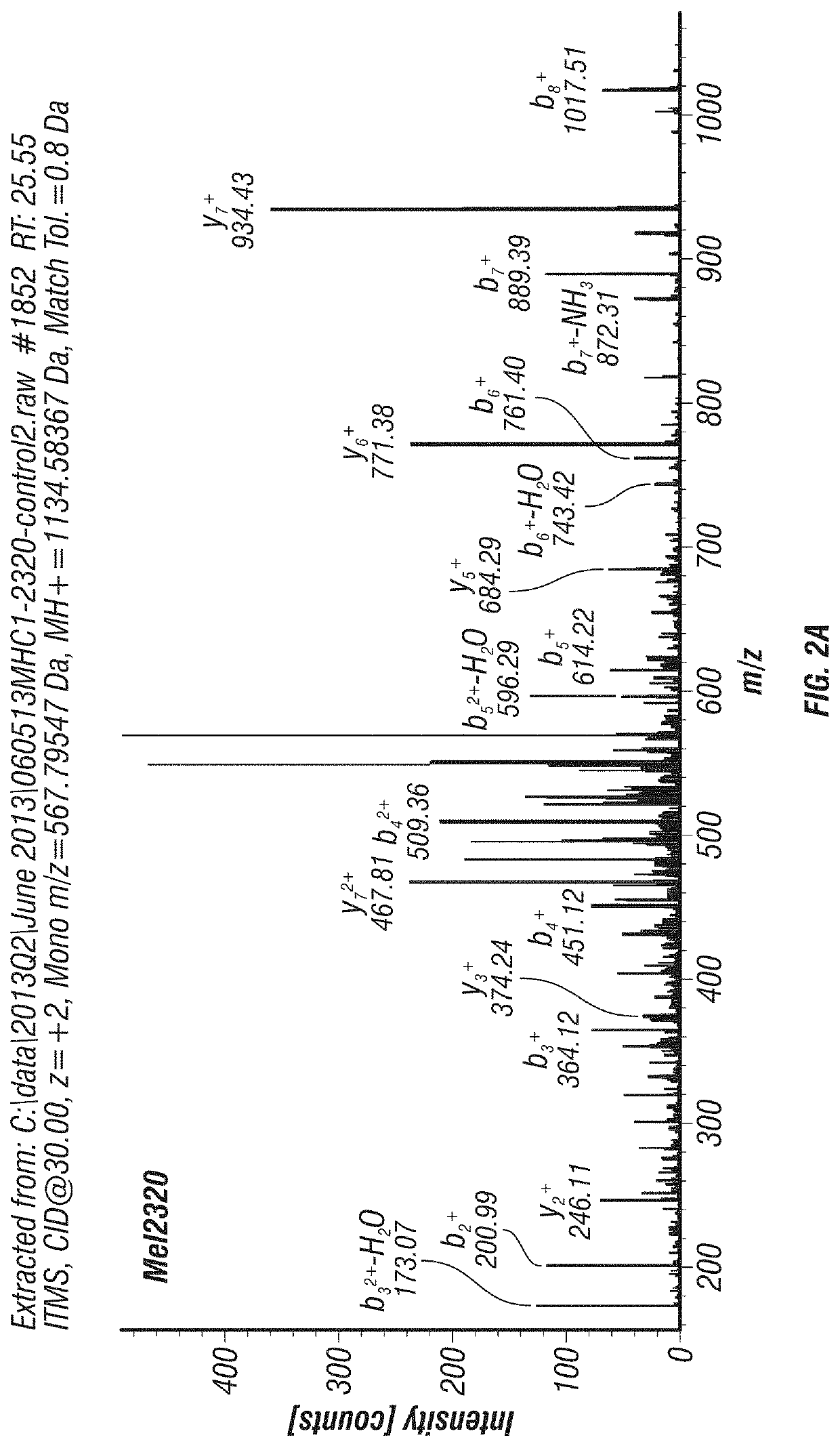Slc45a2 peptides for immunotherapy
a peptide and immunotherapy technology, applied in the field of immunotherapy, can solve the problems of toxicity towards non-cancerous tissues, vitiligo, toxicity in the inner ear, and significant adverse autoimmune side effects, and achieve the effect of effectively killing melanoma cells and reducing toxicity
- Summary
- Abstract
- Description
- Claims
- Application Information
AI Technical Summary
Benefits of technology
Problems solved by technology
Method used
Image
Examples
example 1
Materials and Methods
Donors, Cell Lines and Antibodies
[0164]Peripheral blood (PB) samples were obtained from healthy donors with HLA A*0201 and HLA A*2402.
[0165]Melanoma cell lines were maintained in RPMI1640 with 4 mM L-glutamine, 1 mM non-essential amino acids, 10 mM sodium pyruvate and 50 U / ml penicillin, 50 mg / ml streptomycin and 10% FBS (TCB). Uveal melanomas were cultured with RPMI1640 including 10% FBS, 50 U / ml penicillin, 50 mg / ml and streptomycin. LCL used as feeder cells and cultured with RPMI 1640 containing 10% FBS, 50 U / ml penicillin, 50 mg / ml and streptomycin. CTL media for T cell culture contained 10% FBS, 2 mM L-glutamine, β-mercaptoethanol, 50 U / ml penicillin and 50 mg / ml streptomycin.
HLA Immunoprecipitation and Detection of Bound Peptides by Tandem Mass Spectrometry
[0166]Tumor-associated peptides were directly eluted from HLA class I molecules isolated from fresh tumor tissue specimens or tumor cell lines. Tumor specimens (˜250 mg) were sliced into small pieces and...
example 2
Expression of SLC45A2 is Highly Restricted to Melanomas
[0179]The expression of SLC45A2 was evaluated in various melanoma cells including cutaneous, uveal and mucosal melanoma cells. SLC45A2 mRNA expression was analyzed in tumor cells of various types including melanoma cell lines by RT-PCR (Table 1). SLC45A2 mRNA was detected in most of the melanoma cells, but not in tumor cells of other types (FIGS. 1A-C). The expression of SLC45A2 was also examined in metastatic melanoma cells which originated from different sites (Table 2). 11 of the 16 metastatic melanoma cells tested expressed SLC45A2 mRNA (FIG. 1A). The expression ratio of SLC45A2 was compared with that of other melanoma differentiation antigens (MDA) such as MART-1, gp100 and tyrosinase in various melanoma cells. It was found that the different melanoma differentiation antigens showed a similar expression ratio, 78.7-84.8% (Table 3). Comparison of MDA gene expression in melanomas and primary melanocytes is shown in FIGS. 13A-...
example 3
Identification of HLA-A*0201 and A*2402 Restricted SLC45A2-Derived CD8 T Cell Epitope
[0181]Several MDACC patient-derived melanoma cell lines and fresh melanoma tumor specimens were analyzed for surface HLA class I bound peptides using immunoprecipitation of HLA-A,B,C, acid elution, and tandem mass spectrometry (MS / MS). Six different SLC45A2-derived peptides predicted to bind 4 different HLA alleles were detected from multiple specimens, demonstrating that they constitute shared tumor-associated antigens (Table 4). Additional evidence of these peptides being naturally processed and presented is shown in Table 5: Mel888 melanoma cells were transduced with lentiviral vectors to express either HLA-A*0201, A*2402, or A*0301. Immunopeptidome analysis was performed on parental and transduced Mel888 cells as described above. In this way, 5 of the 6 peptides identified in Table 4 were also detected in the transduced cells, but only if they expressed the appropriate HLA allele (Table 5 and FI...
PUM
| Property | Measurement | Unit |
|---|---|---|
| diameter | aaaaa | aaaaa |
| concentration | aaaaa | aaaaa |
| concentration | aaaaa | aaaaa |
Abstract
Description
Claims
Application Information
 Login to View More
Login to View More - R&D
- Intellectual Property
- Life Sciences
- Materials
- Tech Scout
- Unparalleled Data Quality
- Higher Quality Content
- 60% Fewer Hallucinations
Browse by: Latest US Patents, China's latest patents, Technical Efficacy Thesaurus, Application Domain, Technology Topic, Popular Technical Reports.
© 2025 PatSnap. All rights reserved.Legal|Privacy policy|Modern Slavery Act Transparency Statement|Sitemap|About US| Contact US: help@patsnap.com



